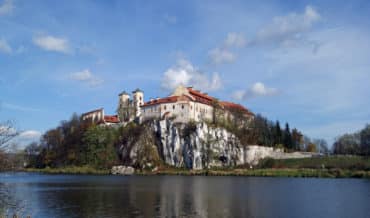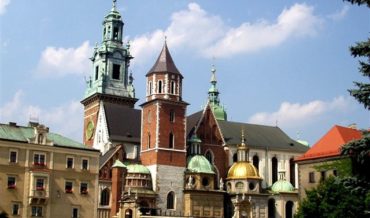Contents
Key Facts
- First abbot of Benedictines brought to Krakow by Casimir I the Restorer
- Born in Cologne according to historical chronicles
- Fifth bishop of Krakow appointed in 1045
- Metropolitan Archbishop of Gniezno (exercising functions from Krakow) after 1048
- Died in 1059 and was buried in Wawel Cathedral
- His heraldic shield features three golden crowns on silver field, still used by Krakow chapter today
- Associated with early Benedictine presence at what would become Tyniec Abbey
Aaron stands as one of the most significant ecclesiastical figures in early Polish history, particularly in the development of Krakow's religious institutions. As the first abbot of Benedictines brought to Krakow by Casimir I the Restorer, Aaron played a pivotal role in establishing the monastic traditions that would shape the spiritual landscape of medieval Poland for centuries to come.
Early Life and Origins
According to historical chronicles, including references in the Rocznik krakowski and works by medieval historians such as Jan Długosz, Aaron was born in Cologne, a major ecclesiastical center of the Holy Roman Empire¹. This Germanic origin was not uncommon for high-ranking clergy in 11th-century Poland, as the country was actively seeking to establish strong ties with Western European Christian institutions following the crisis of 1037-1039².
His education and early ecclesiastical training in Cologne would have provided him with extensive knowledge of Benedictine monastic traditions, liturgical practices, and administrative skills essential for his future role in Poland. Contemporary sources suggest that Cologne's cathedral school was among the most prestigious educational centers of the era, producing clergy who served throughout Central Europe³. This tradition of scholarly excellence in religious education would later be reflected in institutions like the Jagiellonian University, which continued Krakow's legacy as a center of learning.
The choice of Aaron by Casimir I the Restorer reflects the Polish ruler's broader strategy of religious and cultural reconstruction following the pagan uprising and subsequent devastation that had plagued Poland in the early 11th century. By bringing experienced clergy from established Western centers, Casimir aimed to restore and strengthen the Christian foundations of his realm, a policy documented in various 11th-century chronicles⁴.
Episcopal Career in Krakow
Bishop of Krakow (1045-1048)
Aaron's appointment as the fifth bishop of Krakow in 1045 marked a crucial period in the city's ecclesiastical development⁵. Historical evidence suggests that at this time, Krakow was emerging as an increasingly important center of Polish political and religious life, particularly as Gniezno remained vulnerable to external threats.
As bishop, Aaron would have been responsible for:
- Reorganizing the diocesan structure after years of disruption caused by the 1037-1039 crisis
- Establishing new parishes and strengthening existing ones throughout the diocese
- Training local clergy in proper liturgical and administrative practices according to Roman customs
- Overseeing construction and renovation of religious buildings, including early work on what would become Wawel Cathedral
Contemporary historical accounts indicate that his tenure coincided with a period of intensive church building and renovation throughout the diocese, as Casimir I's restoration efforts gained momentum⁶.
Metropolitan Archbishop of Gniezno (1048-1059)
The dramatic elevation of Aaron to Metropolitan Archbishop of Gniezno, exercising his functions from Krakow, came as a direct consequence of the devastating Bohemian raid led by Duke Bretislav I in 1038-1039 and subsequent attacks in 1047-1048⁷. While Gniezno remained the canonical metropolitan see, the practical destruction of its infrastructure necessitated the temporary relocation of archiepiscopal functions to Krakow.
This transition represented more than just an administrative change; it marked Krakow's emergence as the de facto ecclesiastical capital of the Polish kingdom, a role it would maintain even after Gniezno's eventual restoration⁸.
As Metropolitan Archbishop, Aaron faced enormous challenges:
- Rebuilding the church hierarchy across Poland's devastated territories
- Coordinating reconstruction efforts in regions affected by the Bohemian raids
- Maintaining diplomatic relations with Rome, the Holy Roman Empire, and other European ecclesiastical centers
- Supporting Casimir I's political restoration efforts through spiritual and administrative means
Historical sources, including papal correspondence and imperial documents, suggest that Aaron successfully maintained Poland's ecclesiastical connections during this critical period⁹.
Connection to Tyniec Abbey
The relationship between Aaron and the famous Tyniec Benedictine Abbey represents one of the more complex aspects of his legacy, requiring careful historical analysis¹⁰. Medieval tradition attributes to Aaron the initial establishment of Benedictine presence at the Tyniec site, reflecting his documented role in bringing Benedictine monasticism to the Krakow region.
However, scholarly examination of the chronological evidence reveals important nuances. Documentary evidence places the monastery's formal founding charter in 1075¹¹, sixteen years after Aaron's death in 1059. Modern historians, including Tadeusz Manteuffel and Gerard Labuda, have suggested that this discrepancy likely reflects the difference between the initial establishment of a small monastic community (possibly during Aaron's lifetime or under his direction) and the formal founding with full royal endowments and papal privileges (documented in 1075)¹².
This interpretation aligns with common medieval practices where monastic communities often existed informally for years or decades before receiving official recognition and substantial endowments. The strategic importance of Tyniec's location on the Vistula River, approximately 12 kilometers southwest of Krakow, made it an ideal site for a major monastery that could serve both spiritual and economic functions for the growing city¹³.
Death and Burial
Aaron died in 1059 after more than a decade of service as Metropolitan Archbishop, with his death recorded in contemporary annals¹⁴. His burial in Wawel Cathedral was highly significant, as it established an important precedent for Wawel as the primary burial place for Poland's most important religious and political leaders. This tradition would continue for centuries, later including figures such as Queen Jadwiga, demonstrating the lasting impact of Aaron's precedent.
The cathedral, still under construction during Aaron's lifetime according to archaeological evidence, was already emerging as the spiritual heart of the Polish kingdom¹⁵. His interment at Wawel also symbolically reinforced Krakow's status as the new ecclesiastical center of Poland, a position it would maintain for centuries to come. The entire Wawel Castle complex would later develop into an integrated royal and religious center, fulfilling the vision that Aaron's burial there helped to establish.
Aaron's Shield and Heraldic Legacy
The Design and Symbolism
Aaron's shield features three golden crowns on a silver field (in argento tres coronae aureae), a design that carries deep religious and political symbolism documented in medieval heraldic sources¹⁶. The three crowns are traditionally interpreted by heraldic scholars as representing:
- The Trinity (Father, Son, and Holy Spirit) in Christian theological symbolism
- The three kingdoms of the Magi who visited the infant Jesus, connecting to Cologne's claim to house their relics
- Temporal and spiritual authority united under divine rule, reflecting medieval concepts of episcopal power
Connection to Cologne
The heraldic connection to Cologne reflects both Aaron's origins and the broader cultural ties between Poland and the Holy Roman Empire during the 11th century¹⁷. According to heraldic tradition documented in later medieval sources, the shield drew inspiration from Cologne's association with the Three Magi, whose supposed relics were housed in Cologne Cathedral and became central to the city's religious and political identity¹⁸.
This connection would have been especially meaningful given Aaron's Germanic origins and the considerable prestige associated with Cologne's religious traditions throughout medieval Europe.
Modern Legacy in Krakow
Remarkably, Aaron's shield continues to serve as the official coat of arms of the Krakow cathedral chapter to this day, making it one of the oldest continuously used heraldic symbols in the city¹⁹. Visitors to Krakow's Old Town can observe this ancient symbol on various buildings owned by the cathedral chapter, creating a tangible link between medieval and modern Krakow.
The shield's presence on contemporary ecclesiastical buildings serves as a constant reminder of Aaron's foundational role in establishing the religious institutions that continue to define Krakow's character.
Historical Significance and Legacy
Aaron's relatively brief but impactful career had lasting consequences for both Krakow and Poland as a whole, as recognized by leading historians of medieval Poland²⁰. His contributions include:
Institutional Development
- Establishing Benedictine monasticism in southern Poland through his connections to Cologne's monastic networks
- Strengthening diocesan administration during a critical reconstruction period following the 1037-1039 crisis
- Creating precedents for church-state cooperation under Casimir I that influenced Polish ecclesiastical policy for generations
Cultural Impact
- Introducing Western European ecclesiastical practices to Poland, including liturgical reforms and administrative methods
- Fostering connections between Polish and Germanic Christian traditions through his personal networks
- Contributing to Krakow's emergence as a major European ecclesiastical center rivaling Gniezno
Architectural and Artistic Legacy
- Influencing early Romanesque church architecture in the Krakow region through his building programs
- Establishing artistic and liturgical traditions derived from Cologne that persisted for centuries
- Contributing to the development of Wawel as an integrated royal and religious complex
Aaron's story exemplifies the complex cultural exchanges that shaped medieval Central Europe, demonstrating how individual religious leaders could profoundly influence the development of cities, regions, and entire kingdoms. His legacy in Krakow established foundations for the city's enduring religious importance, which would later produce figures like Saint John Kanty and ultimately culminate in the modern era with John Paul II, showing the continuous thread of spiritual leadership that Aaron helped weave into the fabric of the city. This legacy, preserved through architecture, heraldry, and institutional continuity, continues to enrich our understanding of the city's medieval foundations and their enduring influence on its character today.
References
¹ Rocznik krakowski, ed. Z. Kozłowska-Budkowa, Monumenta Poloniae Historica, series nova, vol. 5 (Warsaw, 1978).
² Gerard Labuda, Mieszko II król Polski (1025-1034): czasy przełomu w dziejach państwa polskiego (Kraków: Secesja, 1992).
³ Jerzy Strzelczyk, Adalbert of Prague: A Saint and His Era (Warsaw: InterPress, 1997).
⁴ Gallus Anonymus, Gesta principum Polonorum, ed. K. Maleczyński, Monumenta Poloniae Historica, series nova, vol. 2 (Kraków, 1952).
⁵ Jan Związek, Katalog biskupów krakowskich (Kraków: Wydawnictwo M, 2009).
⁶ Tadeusz Manteuffel, The Formation of the Polish State (Detroit: Wayne State University Press, 1982).
⁷ Dušan Třeštík, Počátky Přemyslovců (Prague: Nakladatelství Lidové noviny, 1997).
⁸ Jerzy Wyrozumski, Dzieje Krakowa, Tom 1: Kraków do schyłku wieków średnich (Kraków: Wydawnictwo Literackie, 1992).
⁹ Codex diplomaticus Poloniae, vol. 1, ed. L. Rzyszczewski and A. Muczkowski (Warsaw, 1847).
¹⁰ Marek Derwich, Monastycyzm benedyktyński w średniowiecznej Polsce (Warsaw: Wydawnictwo DiG, 1998).
¹¹ Codex diplomaticus monasterii Tinecensis, ed. W. Kętrzyński, Monumenta Poloniae Historica, vol. 5 (Lwów, 1888).
¹² Tadeusz Manteuffel, "Początki klasztoru w Tyńcu," Studia Źródłoznawcze 3 (1958): 61-75.
¹³ Kazimierz Dąbrowski, Tyniec w średniowieczu (Kraków: Wydawnictwo Benedyktynów, 1968).
¹⁴ Annales Cracovienses priores, ed. Z. Kozłowska-Budkowa, Monumenta Poloniae Historica, series nova, vol. 5 (Warsaw, 1978).
¹⁵ Adolf Szyszko-Bohusz, Wawel: studium historyczno-architektoniczne (Kraków: Krajowa Agencja Wydawnicza, 1925).
¹⁶ Szymon Okolski, Orbis Polonus (Kraków, 1641-1645).
¹⁷ Marian Gumowski, Heraldyka polska (Warsaw: Państwowe Wydawnictwo Naukowe, 1969).
¹⁸ Wolfgang Braunfels, Abendländische Klosterbaukunst (Cologne: DuMont Schauberg, 1969).
¹⁹ Franciszek Piekosiński, Heraldyka polska wieków średnich (Kraków: Akademia Umiejętności, 1899).
²⁰ Gerard Labuda, Studia nad początkami państwa polskiego (Poznań: Wydawnictwo Naukowe UAM, 1987).

